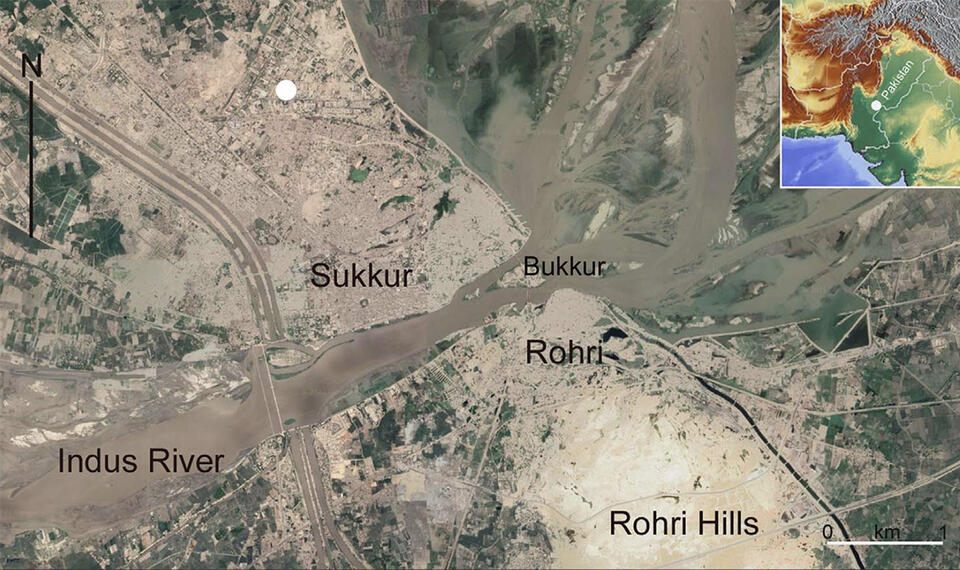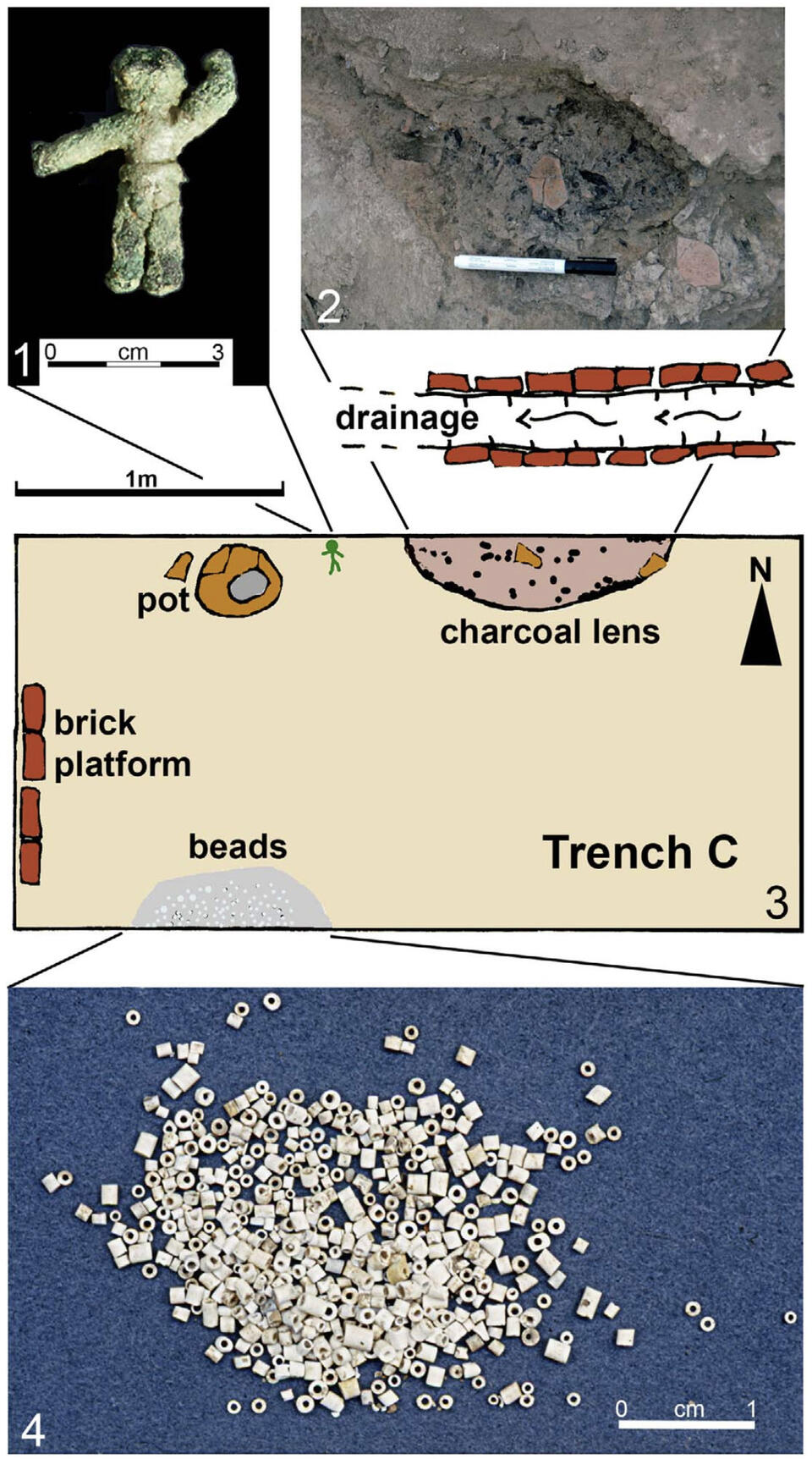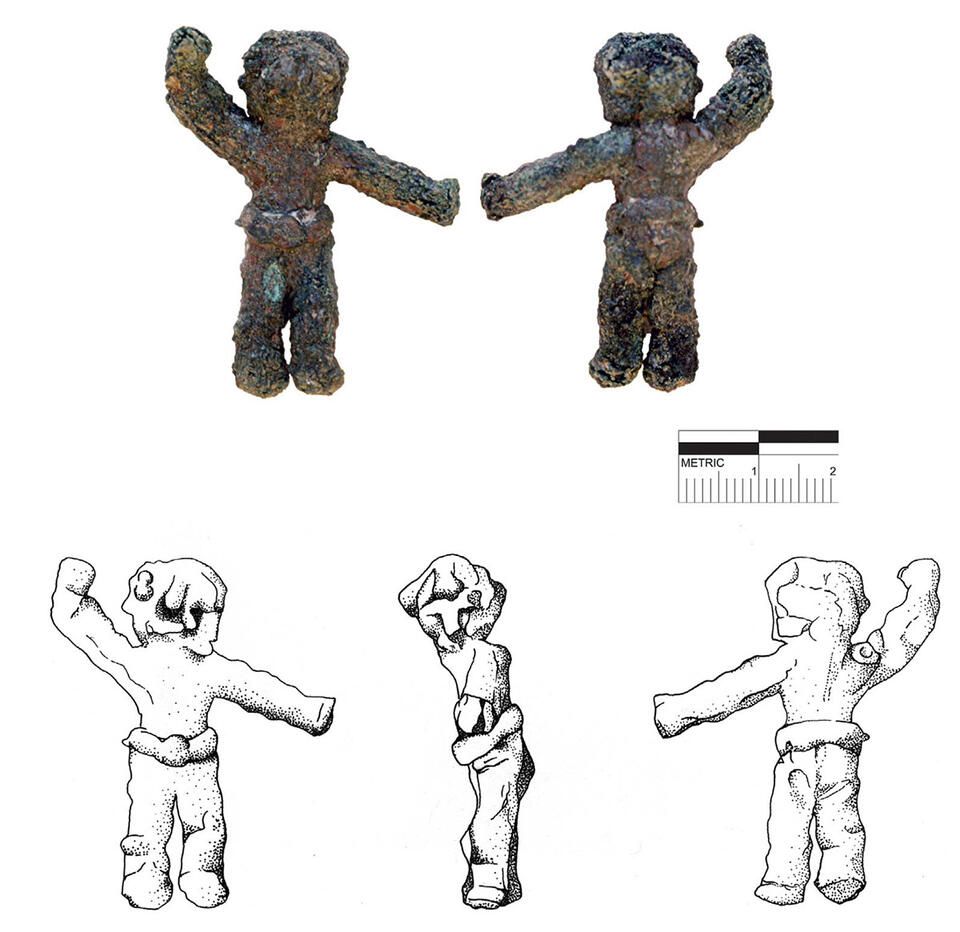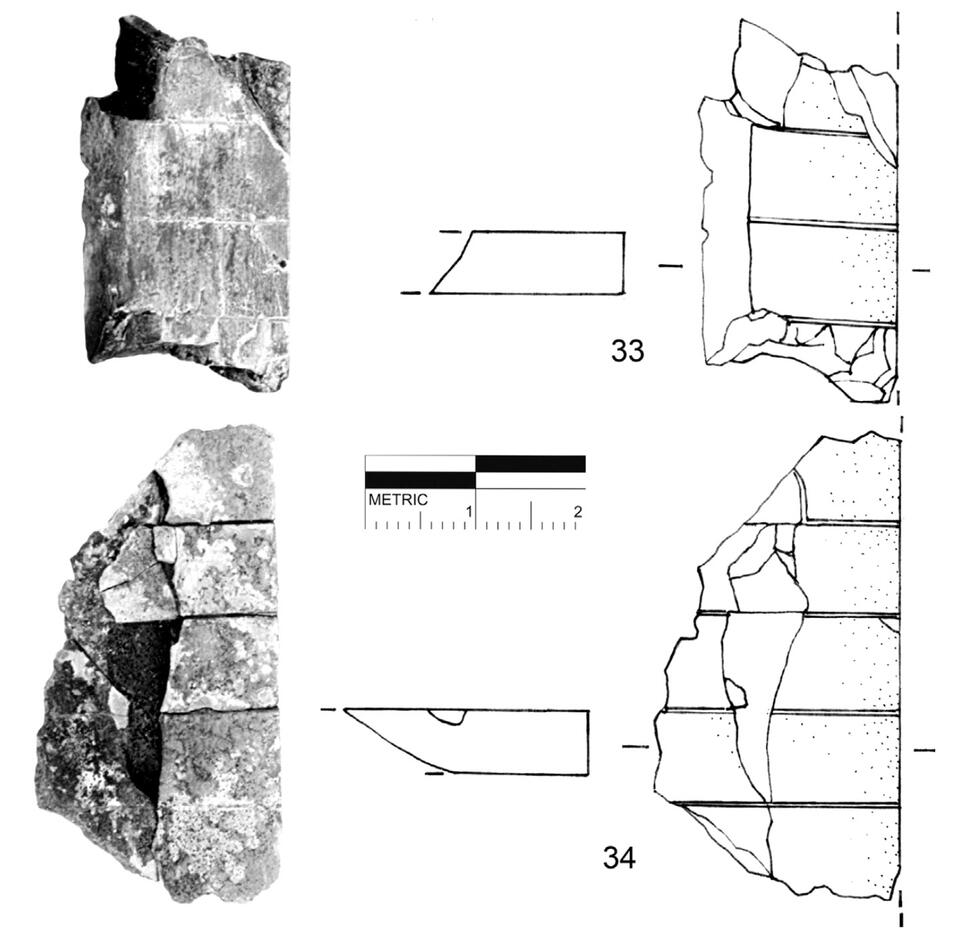We know so little about so many Indus sites, including ones that are buried beneath modern cities and may never be discovered. One such potentially large settlement is Lakheen-Jo-Daro, sometimes also called Lakhan Jo Daro, bits of which have been found in and around the modern city of Sukkur, Sindh, on the Indus River, just across the monumental chert deposits in the Rohri Hills. The materials from these hills must have powered flint, weight and other goods manufacture during if not tens of thousands of years before Indus times. Being so close to such a major raw material source, upstream from Mohenjo-daro might have made this an important urban, manufacturing and/or trading site; the sad thing is that we might never know because of how built up Sukkur is (the ancient Indus site is apparently at least 50 hectares large). Indeed, it has been modern construction that has given us glimpses of what may be below the city's surface, including one area on the northern outskirts that seems to have been an copper craft workshop. Discovered accidentally, it has yielded some remarkable objects described in this excellent article by two renowned Italian archaeologists with long experience of Indus excavations. Remarkably, these are the fruits of test trenches dug in 1996 (see Figure 1 map above), but this article was not published until 2022 (in Asian Perspectives, 2022, 61(1)).
In Trench C of the test excavations, a charcoal sample was discovered and radiocarbon dated to roughly 2000 BCE. "A small group of scrap items and the copper figurine found in this context are then individually described in detail, including information on the conservation and preliminary chemical evidence on the alloys of part of the objects. Finally, we briefly discuss the implications of the finds in the broader picture of Indus copper metallurgy," write the authors. These finds include a heavily corroded, unfinished copper figurine (see the second image showing the distribution of key finds in Trench C, above) which the authors discuss in detail; the excavations, it should be said came in the wake of the partial destruction of the site in an industrial trading estate.
Of the figurine, they report: "Coming from a good stratigraphic context with an associated ordinary radiocarbon date from charcoals of the mid-third millennium cal. B.C. (GrN-23123), the anthropomorphic figurine shown in Figure 6 [Image 3, above] is one of the few artifacts of this type ever found in the Indus repertories. It is 4.4 cm high, 4.00 cm wide (from hand to hand), and about 0.7 cm thick (at the waist above the belt). At 1.25 cm long, the head is disproportionate to the total height of the body. The right arm is 0.58 cm thick, while the left one is 0.55 cm thick. The left leg is 0.7 cm thick at the knee, while at the same point on the right leg measures 0.6 cm. Both the legs and arms end in slightly projecting cylinder-like extremities rather than in natural-looking feet and hands.
"Damage in the form of cracks on the top of the head, right upper arm, and lower legs might have been caused by the exposure of the figurine to an accidental firing (or corrosion). The figurine was X-rayed in a medical shop in Khairpur Mirs (70–80 kV, 12 s). The X-ray plates (not illustrated) showed that a strong spongy corrosion was active at the extremities of the figurine, particularly on top of the upraised right arm, the right foot, and the head. The corroded sub-surface layer here may reach a thickness of 0.2–3 mm; it is a stable patina and should not be removed.
"Several details suggest that the figurine was cast with a lost-wax process and was meant to be finished through a secondary finishing process that never occurred. First, the remnants of the filling of a casting canal - perhaps the only one used in this casting - are visible on the rear of the left shoulder. The canal was cut, but its residue was not filed down. Its setting and angle indicate that the figurine was probably cast in its standing position. Secondly, it is reasonable to assume that a secondary hot-forging process would have provided the figurine with hands and feet. Such forging would probably have also lengthened the legs and the right arm, bringing the overall proportion between the head and total body length closer to a more reasonable ratio of 1/5 to 1/6, which would be more compatible with the elongated bodies of the few other known bronze Indus human figurines (Yule 1985a: tables 1, 2, 3, 6). Most copper human figurines feature a hair bun at the rear of the head, so it is also possible that the head looks larger and thicker than usual because this feature was badly cast or the bun was meant to be emphasized in subsequent forging.
"The face is schematically suggested by a straight, flat nose and by the horizontal eye sockets. When one looks at the figurine from the front, the impression is that the image looks at the observer, but it actually looks to the left outstretched arm, as if aiming at a target. The person might wear a cap or some kind of head-dress, as suggested by some irregular folds. The folds are slightly deformed by corrosion, however, particularly on the temples and the front, so what they signify remains quite uncertain.
"The figure is naked except for a belt enhanced by a round buckle or bead in low relief, a decorative element not uncommon in female terracotta figurines (Clark 2009, 2018). Despite the lack of genitalia, it is likely a male image.5 The left arm is outstretched downward in front of the figurine, while the right one is lifted up to the height of the head, as though ready to strike. One notices the ill-proportioned length of the forearm, when compared with the rest. The body is slightly curved, with the left leg bent and projecting onward, while the right one, at rear, seems to balance the body’s weight. Although the legs seem short and somehow clumsy, on the whole the posture is naturalistic and well-rendered; it very effectively suggests the bodily tension of a person in the act of throwing a spear.
"Damage in the form of cracks on the top of the head, right upper arm, and lower legs might have been caused by the exposure of the figurine to an accidental firing (or corrosion). The figurine was X-rayed in a medical shop in Khairpur Mirs (70–80 kV, 12 s). The X-ray plates (not illustrated) showed that a strong spongy corrosion was active at the extremities of the figurine, particularly on top of the upraised right arm, the right foot, and the head. The corroded sub-surface layer here may reach a thickness of 0.2–3 mm; it is a stable patina and should not be removed" (pp. 10-12).
There are a variety of other copper hoard objects found and illustrated including micro-tubes that might have been used for extruding steatite paste, a variety of folded sheets, and other fragments of copper hoard objects accidentally soldered together by corrosion: "On the whole, the small collection of copper alloy objects seems to belong to a small scrap hoard. Presumably, the copper objects were originally gathered within a small bag-like container that was subsequently lost on the floor during a destructive event. After burial, the scraps within the bag were altered by corrosion adhering one to the other; this retained them in their relative positions brought on by the original loss event" (p. 21).
There are also two fragments of ivory that speak to a measuring device of some kind, perhaps what some have termed an Indus scale, which is exciting (see Image 4, above).
In their Conclusion, reproduced below in full, the authors speak to the larger challenges and directions for future work the finds suggest, and to the enormous luck that often accompanies archaeological discovery even within such a problematic area with respect to modern construction activity: "Many settlements attributable to the Indus Civilization are known around Sukkur in Upper Sindh, though only a few of them have been recorded and excavated and even fewer have been dated. This lack of research interest in the region greatly contrasts with new research strategies put forward in neighboring regions of South Asia (e.g., Green et al. 2019). Fragmentary evidence nevertheless confirms once again that Lakheen-Jo-Daro was a very important Bronze Age settlement of the Upper Sindh and that it was deeply involved in craft production.
"Despite the richness of the complex architectural and characteristic material culture remains, the wider trenches opened during the excavations at Lakheen-Jo-Daro over the last two decades have not yielded any other unusual finds (Mallah 2017; Shaikh et al. 2004–2005). The lucky discovery made in Trench C of a scrap hoard of copper items, a complete copper anthropomorphic figurine, and other important ornamental and functional artifacts within a radiocarbon-dated context fills in some gaps in our knowledge of Mature Indus technologies. As Hoffman and Miller (2009:248) remarked:
'Patterns of alloying are likely obscured..because the Indus metalsmiths used alloying for a variety of purposes—functional, aesthetic, ritual, and/or simply expedient..[and] by sampling and excavation problems, as well as the prevalence of Indus recycling, as seen in the numerous caches of metal objects and scraps recovered from all of the major sites.'
"The discovery at Lakheen-Jo-Daro demands renewed attention on the batches of scraps stored and prepared for re-melting at other old and new sites, and the need for proper chemical studies of their alloys, no matter how small or formally meaningless the objects might appear.
The finds also suggest a question about the sets of tiny copper tubes, similar to those found at Chanhu-Daro, and their hypothesized use in the steatite bead and microbead manufacturing industries. This aspect of the Trench C assemblage (Law 2018; Miller 2008) is even more relevant in light of the very abundant steatite disk bead waste recovered from the same site (Mallah 2017).
"The discoveries made at Lakheen-Jo-Daro thus contribute to the study of some important aspects of the Indus Civilization in the region covered by the so-called Greater Indus Valley (Mughal 1973:39). Recent excavations at Lakheen-jo-Daro and Chanhu-Daro, both in the course of being published, will provide us with new important insights into craft development and socio-economic organization during the beginning of the Mature Indus period" (p. 22).
One can only hope that further work is one day possible at the site - the discovery of another large city between Mohenjo-daro and Harappa could only make ancient Indus studies even more interesting if not modify our thoughts about urbanization in the region.
Images: 1. The landscape surrounding Lakheen-Jo-Daro (white dot), including location of Aror (black dot) and the most visible fossil river branches (^) buried in the Indus alluvial plain (created by P. Biagi, base map from Google Earth, 01/20/2021, Image Landsat/Copernicus, 2021 Maxar Technologies).
2. Important finds retrieved from Mound D, Trench C at Lakheen-Jo-Daro: (1) figurine; (2) charcoal lens; (3) distribution of finds in Trench C; (4) paste micro-beads (photographs by M. Vidale; distribution map by E. Starnini).
3. Different views of copper anthropomorphic figurine found in Lakheen-Jo-Daro Mound D, Trench C (drawings and photographs by M. Vidale).
4. Lakheen-Jo-Daro Mound D, Trench C objects 33–34: two fragments of ivory with parallel incisions on surface suggesting a possible scale (drawings and photographs by M. Vidale).








